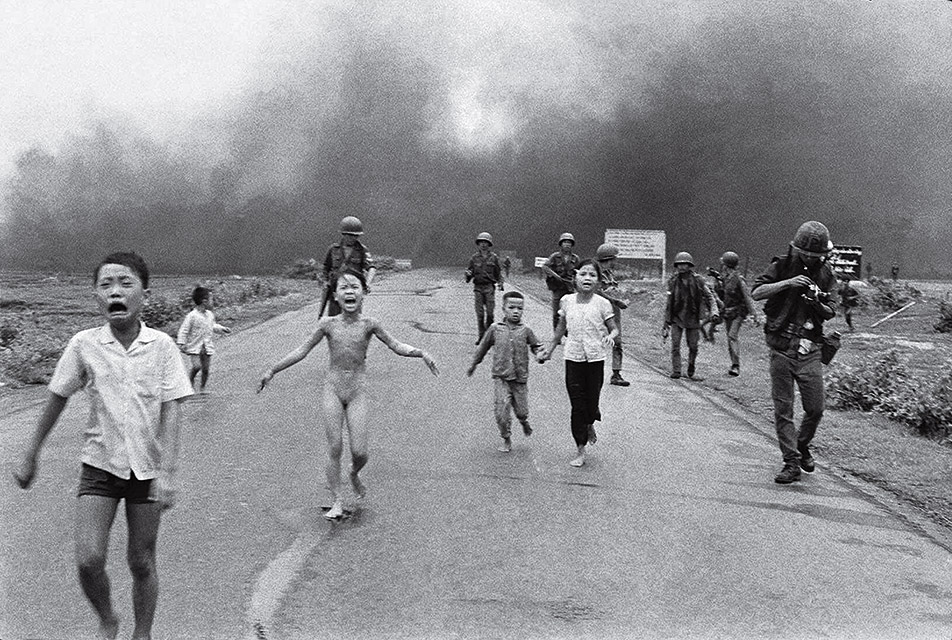The Napalm Girl Matters More Today Than Ever Before
By Sarah Westrick | September 10, 2019

Though the entirety of the display is nothing short of captivating, it is hard, when one walks into the pulitzer photograph exhibit at the Newseum, to tear the eyes away from one particular image, that of Vietnamese citizens in 1972, fleeing from painfully hot napalm. It is then equally as hard not to think about similar images to this one, these ones in color, taken not decades, but mere months ago.
The haunting snapshot that hangs in the pulitzer gallery was captured by Associated Press photographer Nick Ut outside the village of Trang Bang on June 8, 1972, as South Vietnamese forces mistakenly dropped napalm onto civilians, delivering searing third degree burns to residents and scorching a nine year-old girl’s clothes completely off.
This nine year old girl was Phan Thi Kim Phuc, who Ut initially brought to the hospital, and then to an American care center, which saved her life.
Napalm, sometimes known as “liquid fire”, was first synthesized in 1943 at Harvard University under the supervision of chemistry professor Lous F. Fiesser. Although a primitive version was used by both allied and axis powers during the first World War, true napalm was not utilized in combat until World War II.
The image, though it initially had to fight censorship battles to be allowed publication (for nudity), became one of many hallmark photographs exposing the war’s brutalities. The sitting president, Richard Nixon, even tried to imply that the photo was fake (to which Ut replied “The horror of the Vietnam war recorded by me did not have to be fixed.”) The war ended a year later.
Napalm was only one of the many brutal chemicals used during the Vietnam War. The U.S. also utilized a chemical dubbed “Agent Orange”, designed to kill crops and vegetation that gave cover to Viet Kong troops. The environmental degradation from Operation Ranch Hand (in which Agent Orange was sprayed across a variety of ecosystems) decimated hardwood forests to mangrove swamps and the organisms living there. Not only have these ecological communities had to recover, but the toxic compound dioxin has had adverse health effects upon civilians, the scope of which could still use more study.
The “Napalm Girl” photo added strength to the anti-war movement, and the use of napalm on civilian targets was outlawed by the UN less than ten years later, in 1980. But it would be completely wrong to say that the shot’s legacy ends there.
If so many saw and felt so strongly about the napalm girl, why then, can we still see images like the one below, taken just two years ago, after Bashar Al-Assad ordered chemical attacks in shared military and civilian areas?

In April 2018, the U.S. ordered airstrikes on three Syrian government locations in response to the continued use by the Assad regime of chemical gases and agents, not exactly but also not unlike napalm.
One of the weapons more-so utilized today is chlorine gas, the effects of which are pictured above. The gas causes acute respiratory damage and irritation to the eyes and mouth, the severity of which is dependent upon the dosage and the duration of exposure. Chlorine gas has several practical uses in industry, but its use as a weapon was universally outlawed by the participation of countries in the 1997 Chemical Weapons Convention. he Assad regime
After this airstrike, media coverage surrounding the use of such tactics in Syria diminished. But now, in 2019, reports again are surfacing that the regime is again targeting areas with chemical weapons like chlorine gas.
Basic regard for civilian livelihood has always been an unofficial rule of war and combat, but it has also routinely been ignored during particularly desperate conflicts, (like the Vietnam war and the Syrian civil war). Even for military targets, the bans upon attacks with the use of agents are meant to prevent extreme and bloody atrocities. All we can do to move forward is to decipher how best to prevent militaries from feeling the need to use these kinds of weapons.
The image of the napalm girl was horrifying then and is horrifying now. Let’s not forget the impact that it had then so that we keep our focus on that same fight for non-violence as it unfolds now.
BBC. 14 April 2018. Syria air strikes: US and allies attack ‘chemical weapons sites’. <URL> 10 September 2019.
Global Security. 7 July 2011. Napalm. <URL> 10 September 2019.
The Conversation, Jason von Meding. 3 October 2017. Agent Orange, exposed: How U.S. chemical warfare in Vietnam unleashed a slow-moving disaster. <URL> 10 September 2019.
The National Center for Biotechnology Information. Chlorine Gas Toxicity. <URL> 10 September 2019.
The New York Times, Edward Wong. 21 May 2019. U.S. Says Assad May Be Using Chemical Weapons in Syria Again. <URL> 10 September 2019.
Time Magazine. The Terror of War. <URL> 10 September 2019.